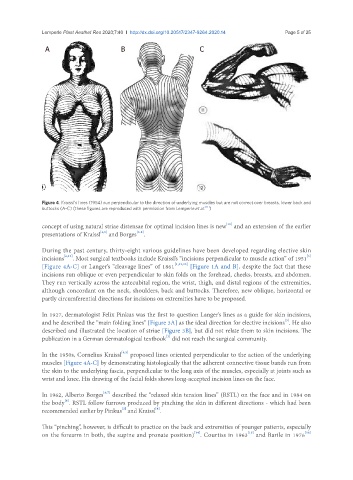Page 436 - Read Online
P. 436
Lemperle Plast Aesthet Res 2020;7:40 I http://dx.doi.org/10.20517/2347-9264.2020.14 Page 5 of 25
A B C
Figure 4. Kraissl’s lines (1954) run perpendicular to the direction of underlying muscles but are not correct over breasts, lower back and
[11]
buttocks (A-C) (these figures are reproduced with permission from Lemperle et al. )
[11]
concept of using natural striae distensae for optimal incision lines is new and an extension of the earlier
[4,5]
[6-8]
presentations of Kraissl and Borges .
During the past century, thirty-eight various guidelines have been developed regarding elective skin
incisions [6,12] . Most surgical textbooks include Kraissl’s “incisions perpendicular to muscle action” of 1951
[5]
[Figure 4A-C] or Langer’s “cleavage lines” of 1861 [1,12,13] [Figure 1A and B], despite the fact that these
incisions run oblique or even perpendicular to skin folds on the forehead, cheeks, breasts, and abdomen.
They run vertically across the antecubital region, the wrist, thigh, and distal regions of the extremities,
although concordant on the neck, shoulders, back and buttocks. Therefore, new oblique, horizontal or
partly circumferential directions for incisions on extremities have to be proposed.
In 1927, dermatologist Felix Pinkus was the first to question Langer’s lines as a guide for skin incisions,
and he described the “main folding lines” [Figure 3A] as the ideal direction for elective incisions . He also
[3]
described and illustrated the location of striae [Figure 3B], but did not relate them to skin incisions. The
[3]
publication in a German dermatological textbook did not reach the surgical community.
[4,5]
In the 1950s, Cornelius Kraissl proposed lines oriented perpendicular to the action of the underlying
muscles [Figure 4A-C] by demonstrating histologically that the adherent connective tissue bands run from
the skin to the underlying fascia, perpendicular to the long axis of the muscles, especially at joints such as
wrist and knee. His drawing of the facial folds shows long-accepted incision lines on the face.
[6,7]
In 1962, Alberto Borges described the “relaxed skin tension lines” (RSTL) on the face and in 1984 on
[8]
the body . RSTL follow furrows produced by pinching the skin in different directions - which had been
[2]
[4]
recommended earlier by Pinkus and Kraissl .
This “pinching”, however, is difficult to practice on the back and extremities of younger patients, especially
[16]
on the forearm in both, the supine and pronate position) . Courtiss in 1963 and Barile in 1976
[15]
[14]

